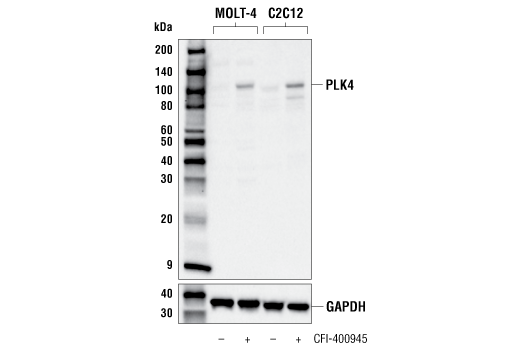WB
H M
Endogenous
105
Rabbit IgG
#O00444
10733
Product Information
Product Usage Information
| Application | Dilution |
|---|---|
| Western Blotting | 1:1000 |
Storage
Specificity / Sensitivity
Species Reactivity:
Human, Mouse
Source / Purification
Monoclonal antibody is produced by immunizing animals with a synthetic peptide corresponding to residues surrounding Leu678 of human PLK4 protein.
Background
At least four distinct polo-like kinases exist in mammalian cells: PLK1, PLK2, PLK3, and PLK4/SAK (1). PLK4/SAK is transcriptionally repressed by p53 and may contribute to p53-mediated apoptosis (2). PLK4 has also been identified as a key regulator of centriole duplication (3-5). PLK4 is typically expressed at low levels and is controlled by autoregulated instability such that treatment with PLK4 inhibitors, such as CFI-400945, leads to an increase in PLK4 expression (6,7). PLK4 is aberrantly expressed in multiple cancers and has emerged as a potential prognostic and therapeutic target (8).
- Nigg, E.A. (1998) Curr Opin Cell Biol 10, 776-83.
- Li, J. et al. (2005) Neoplasia 7, 312-23.
- Habedanck, R. et al. (2005) Nat Cell Biol 7, 1140-6.
- Ko, M.A. et al. (2005) Nat Genet 37, 883-8.
- Bettencourt-Dias, M. et al. (2005) Curr Biol 15, 2199-207.
- Holland, A.J. et al. (2012) Genes Dev 26, 2684-9.
- Mason, J.M. et al. (2014) Cancer Cell 26, 163-76.
- Zhao, Y. and Wang, X. (2019) J Cancer Res Clin Oncol 145, 2413-22.
Species Reactivity
Species reactivity is determined by testing in at least one approved application (e.g., western blot).
Western Blot Buffer
IMPORTANT: For western blots, incubate membrane with diluted primary antibody in 5% w/v BSA, 1X TBS, 0.1% Tween® 20 at 4°C with gentle shaking, overnight.
Applications Key
WB: Western Blotting
Cross-Reactivity Key
H: human M: mouse R: rat Hm: hamster Mk: monkey Vir: virus Mi: mink C: chicken Dm: D. melanogaster X: Xenopus Z: zebrafish B: bovine Dg: dog Pg: pig Sc: S. cerevisiae Ce: C. elegans Hr: horse GP: Guinea Pig Rab: rabbit All: all species expected
Trademarks and Patents
Limited Uses
Except as otherwise expressly agreed in a writing signed by a legally authorized representative of CST, the following terms apply to Products provided by CST, its affiliates or its distributors. Any Customer's terms and conditions that are in addition to, or different from, those contained herein, unless separately accepted in writing by a legally authorized representative of CST, are rejected and are of no force or effect.
Products are labeled with For Research Use Only or a similar labeling statement and have not been approved, cleared, or licensed by the FDA or other regulatory foreign or domestic entity, for any purpose. Customer shall not use any Product for any diagnostic or therapeutic purpose, or otherwise in any manner that conflicts with its labeling statement. Products sold or licensed by CST are provided for Customer as the end-user and solely for research and development uses. Any use of Product for diagnostic, prophylactic or therapeutic purposes, or any purchase of Product for resale (alone or as a component) or other commercial purpose, requires a separate license from CST. Customer shall (a) not sell, license, loan, donate or otherwise transfer or make available any Product to any third party, whether alone or in combination with other materials, or use the Products to manufacture any commercial products, (b) not copy, modify, reverse engineer, decompile, disassemble or otherwise attempt to discover the underlying structure or technology of the Products, or use the Products for the purpose of developing any products or services that would compete with CST products or services, (c) not alter or remove from the Products any trademarks, trade names, logos, patent or copyright notices or markings, (d) use the Products solely in accordance with CST Product Terms of Sale and any applicable documentation, and (e) comply with any license, terms of service or similar agreement with respect to any third party products or services used by Customer in connection with the Products.
